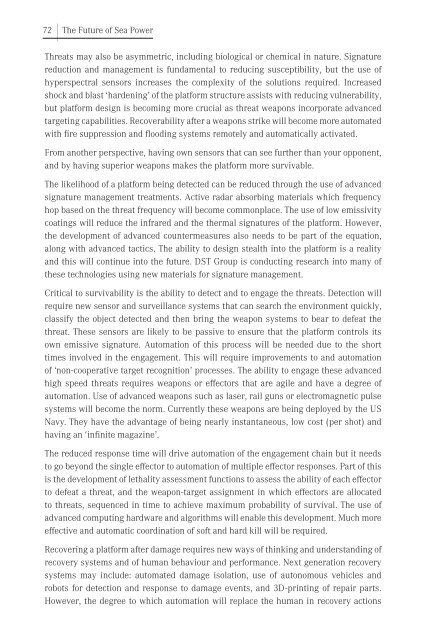THE FUTURE OF SEA POWER
SPC2015_Proceedings
SPC2015_Proceedings
You also want an ePaper? Increase the reach of your titles
YUMPU automatically turns print PDFs into web optimized ePapers that Google loves.
72 |<br />
The Future of Sea Power<br />
Threats may also be asymmetric, including biological or chemical in nature. Signature<br />
reduction and management is fundamental to reducing susceptibility, but the use of<br />
hyperspectral sensors increases the complexity of the solutions required. Increased<br />
shock and blast ‘hardening’ of the platform structure assists with reducing vulnerability,<br />
but platform design is becoming more crucial as threat weapons incorporate advanced<br />
targeting capabilities. Recoverability after a weapons strike will become more automated<br />
with fire suppression and flooding systems remotely and automatically activated.<br />
From another perspective, having own sensors that can see further than your opponent,<br />
and by having superior weapons makes the platform more survivable.<br />
The likelihood of a platform being detected can be reduced through the use of advanced<br />
signature management treatments. Active radar absorbing materials which frequency<br />
hop based on the threat frequency will become commonplace. The use of low emissivity<br />
coatings will reduce the infrared and the thermal signatures of the platform. However,<br />
the development of advanced countermeasures also needs to be part of the equation,<br />
along with advanced tactics. The ability to design stealth into the platform is a reality<br />
and this will continue into the future. DST Group is conducting research into many of<br />
these technologies using new materials for signature management.<br />
Critical to survivability is the ability to detect and to engage the threats. Detection will<br />
require new sensor and surveillance systems that can search the environment quickly,<br />
classify the object detected and then bring the weapon systems to bear to defeat the<br />
threat. These sensors are likely to be passive to ensure that the platform controls its<br />
own emissive signature. Automation of this process will be needed due to the short<br />
times involved in the engagement. This will require improvements to and automation<br />
of ‘non-cooperative target recognition’ processes. The ability to engage these advanced<br />
high speed threats requires weapons or effectors that are agile and have a degree of<br />
automation. Use of advanced weapons such as laser, rail guns or electromagnetic pulse<br />
systems will become the norm. Currently these weapons are being deployed by the US<br />
Navy. They have the advantage of being nearly instantaneous, low cost (per shot) and<br />
having an ‘infinite magazine’.<br />
The reduced response time will drive automation of the engagement chain but it needs<br />
to go beyond the single effector to automation of multiple effector responses. Part of this<br />
is the development of lethality assessment functions to assess the ability of each effector<br />
to defeat a threat, and the weapon-target assignment in which effectors are allocated<br />
to threats, sequenced in time to achieve maximum probability of survival. The use of<br />
advanced computing hardware and algorithms will enable this development. Much more<br />
effective and automatic coordination of soft and hard kill will be required.<br />
Recovering a platform after damage requires new ways of thinking and understanding of<br />
recovery systems and of human behaviour and performance. Next generation recovery<br />
systems may include: automated damage isolation, use of autonomous vehicles and<br />
robots for detection and response to damage events, and 3D-printing of repair parts.<br />
However, the degree to which automation will replace the human in recovery actions


